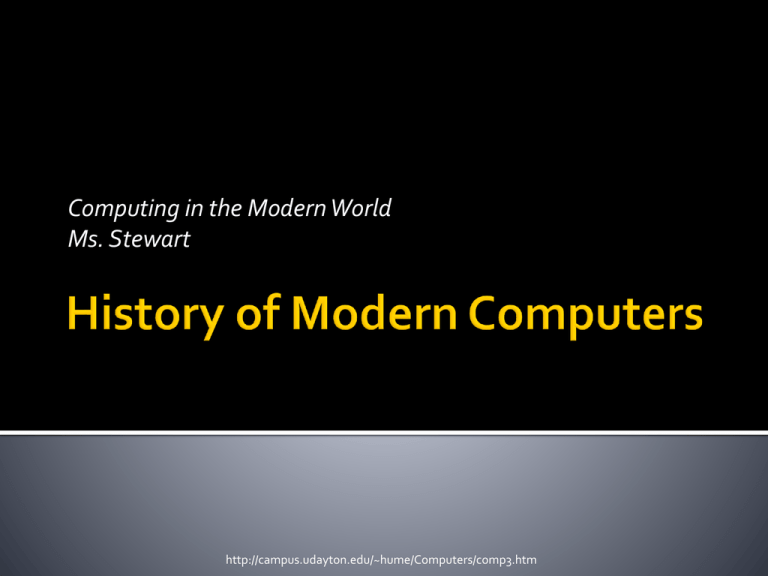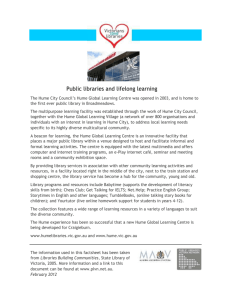History of Modern Computers
advertisement

Computing in the Modern World Ms. Stewart http://campus.udayton.edu/~hume/Computers/comp3.htm The evolution of modern computers is divided into a few "distinct" generations. http://campus.udayton.edu/~hume/Computers/comp3.htm Each generation is characterized by extreme improvements over the prior era in the technology used in the: manufacturing process, the internal layout of computer systems, and programming languages. http://campus.udayton.edu/~hume/Computers/comp3.htm 1945-1956 Computers were mainly used by the government for use in war and designing strategies. Konrad Zuse (1941) used computers to design airplanes and missiles. The British designed a computer to decode secret messages (1943). http://campus.udayton.edu/~hume/Computers/comp3.htm 1945-1956 Aiken created an electronic calculator (1944) to create charts for the Navy. It was half as long as a football field. ENIAC computer (1945) was a general purpose computer used to design the hydrogen bomb. http://campus.udayton.edu/~hume/Computers/comp3.htm 1945-1956 Neumann designed the EDVAC computer (1945), which was able to store a program as well as data. The computer could also be stopped and re-started – a first for this time period. Key development was the Central Processing Unit (CPU). http://campus.udayton.edu/~hume/Computers/comp3.htm 1945-1956 Eckert and Mauchly developed the UNIVAC I (1951). It was the first commercially successful computer. http://campus.udayton.edu/~hume/Computers/comp3.htm 1956 – 1963 The invention of the transistor greatly changed the computer's development. The transistor replaced the large, cumbersome vacuum tube in televisions, radios and computers. As a result, the size of electronic machinery has been shrinking ever since. http://campus.udayton.edu/~hume/Computers/comp3.htm 1956 – 1963 Transistors led to second generation computers that were smaller, faster, more reliable and more energy-efficient than their ancestors. http://campus.udayton.edu/~hume/Computers/comp3.htm 1956 – 1963 The Stretch by IBM and LARC by Sperry-Rand were supercomputers developed for atomic energy laboratories and could handle an enormous amount of data. The machines were costly, however, and tended to be too powerful for the business sector's computing needs, thereby limiting their attractiveness. http://campus.udayton.edu/~hume/Computers/comp3.htm 1956 – 1963 Throughout the early 1960's, there were a number of commercially successful second generation computers used in businesses, universities, and government. http://campus.udayton.edu/~hume/Computers/comp3.htm 1956 – 1963 They contained all the components we associate with the modern day computer: printers, tape storage, disk storage, memory, and stored programs. An example was the IBM 1401. http://campus.udayton.edu/~hume/Computers/comp3.htm http://campus.udayton.edu/~hume/Computers/comp3.htm 1956 – 1963 It was the stored program and programming language that gave computers the flexibility to finally be cost effective and productive for business use. http://campus.udayton.edu/~hume/Computers/comp3.htm 1956 – 1963 The stored program concept meant that instructions to run a computer for a specific function (known as a program) were held inside the computer's memory, and could quickly be replaced by a different set of instructions for a different function. For example, print one minute, then design documents the next. http://campus.udayton.edu/~hume/Computers/comp3.htm 1956 – 1963 More sophisticated high-level languages such as COBOL (Common Business-Oriented Language) and FORTRAN (Formula Translator) came into common use during this time, and have expanded to the current day. These languages replaced cryptic binary machine code with words, sentences, and mathematical formulas, making it much easier to program a computer. http://campus.udayton.edu/~hume/Computers/comp3.htm 1956 – 1963 New types of careers (programmer, analyst, and computer systems expert) and the entire software industry began with second generation computers. http://campus.udayton.edu/~hume/Computers/comp3.htm 1964 – 1971 Transistors, when first created, generated massive amounts of heat. Kilby (1958) developed an integrated circuit to use in the place of transistors. http://campus.udayton.edu/~hume/Computers/comp3.htm 1964 – 1971 The IC combined three electronic components onto a small silicon disc, which was made from quartz. Scientists later managed to fit even more components on a single chip, called a semiconductor. As a result, computers became ever smaller as more components were squeezed onto the chip. http://campus.udayton.edu/~hume/Computers/comp3.htm 1964 – 1971 Another development was Windows Vista MAC the use of an operating system that allowed machines to run many different programs at once with a central program that monitored and coordinated Operating Systems (examples) Programs (examples) Word Excel Access PowerPoint Windows Media Player Skype the computer's memory. http://campus.udayton.edu/~hume/Computers/comp3.htm Thompson and Ritchie (1969) developed the UNIX operating system. UNIX was the first modern operating system that provided a sound intermediary between software and hardware. http://campus.udayton.edu/~hume/Computers/comp3.htm 1971 – present The next step in the computer design process was to reduce the overall size. Hundreds of thousands of components were squeezed onto a chip. http://campus.udayton.edu/~hume/Computers/comp3.htm




